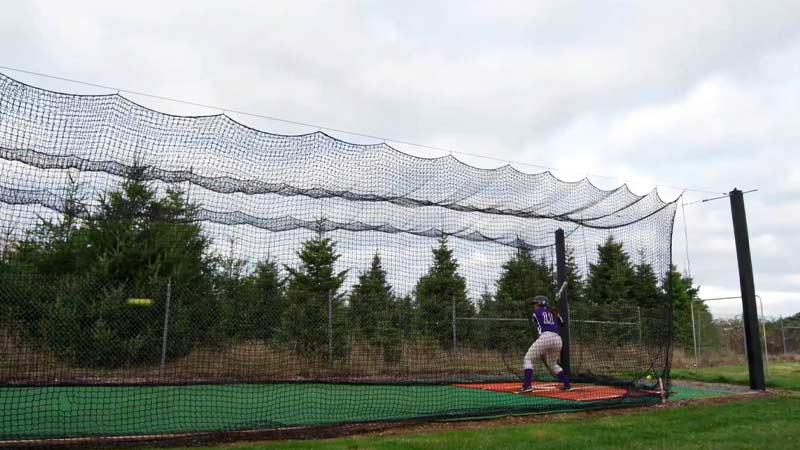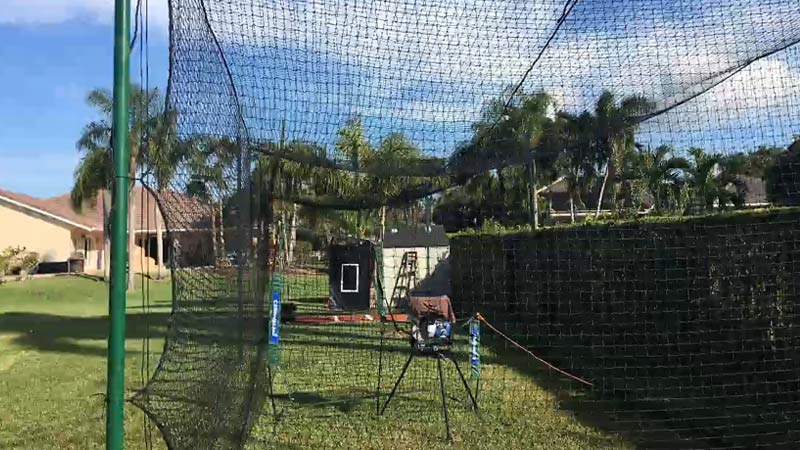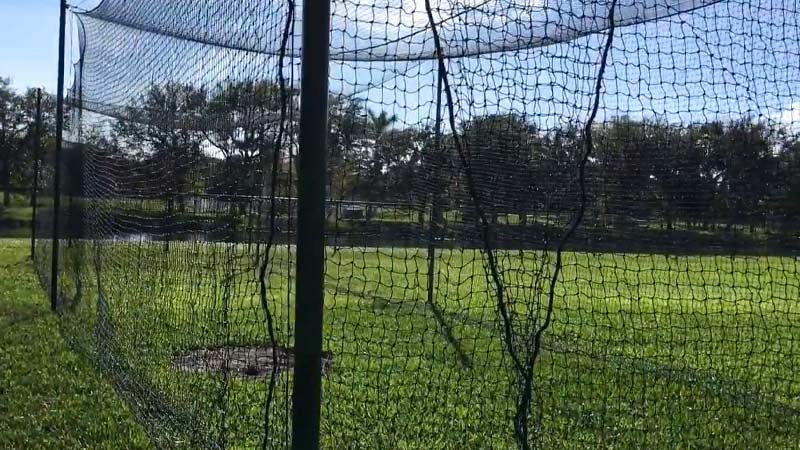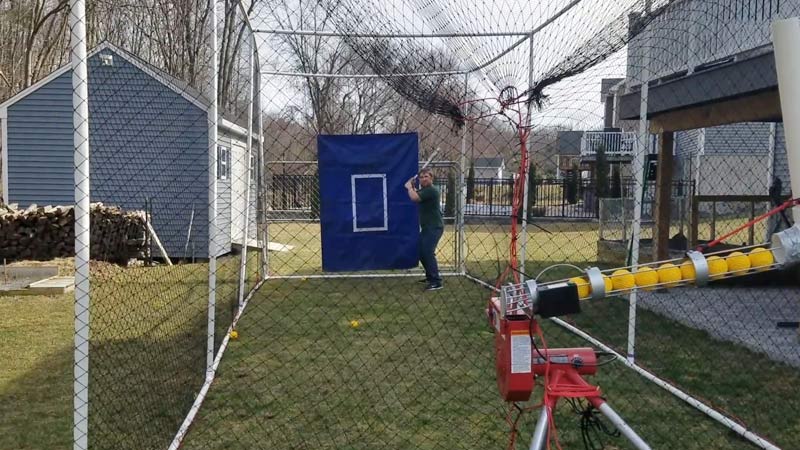Embarking on the journey to craft a PVC batting cage is a rewarding venture for sports enthusiasts eager to refine their hitting prowess.
This do-it-yourself project not only provides a cost-effective solution but also allows for a personalized practice space tailored to individual needs.
By utilizing readily available PVC pipes, connectors, and durable netting, creating a batting cage becomes an accessible endeavor.
This step-by-step guide navigates through the process, ensuring a sturdy frame, secure netting, and an environment conducive to honing batting skills.
Dive into the world of DIY athleticism and transform your backyard into a dedicated space for perfecting the art of hitting.
Step-by-Step Guide to Make a PVC Batting Cage

Building a PVC batting cage can be a fun and rewarding project for any baseball or softball enthusiast.
Here’s a step-by-step guide to help you create your very own PVC batting cage:
Materials Needed:
- PVC pipes (1-inch diameter is commonly used)
- PVC connectors (elbows, tees, and crosses)
- Netting (heavy-duty, UV-resistant)
- Nylon cable ties
- Ground stakes or sandbags (to secure the frame)
- Measuring tape
- PVC pipe cutter or hacksaw
- Drill with bits
- Screwdriver
- Level
Instructions:
Step 1: Design and Planning
Begin by deciding the purpose of your batting cage. Is it for casual practice or serious training? Determine the dimensions accordingly.
Measure the available space in your backyard or desired location. Sketch out a basic plan that includes the length, width, and height of the cage. This plan will serve as your blueprint throughout the construction process.
Step 2: Gather Materials
Head to your local hardware store or home improvement center to purchase the necessary materials.
Opt for PVC pipes with a 1-inch diameter for a good balance of strength and flexibility.
Select PVC connectors such as elbows, tees, and crosses to fit your design. Invest in heavy-duty, UV-resistant netting for durability.
Step 3: Cut PVC Pipes
Carefully measure and mark the PVC pipes according to your design. Use a PVC pipe cutter or hacksaw to make precise cuts.
Remember to wear safety gear, including goggles and gloves, to protect yourself from any sharp edges.
Step 4: Assemble the Frame
Lay out the cut PVC pipes on the ground according to your design. Begin connecting the pieces using elbows, tees, and crosses to form the frame.
Pay attention to the alignment and angles, ensuring the frame is both sturdy and level. A helping hand might come in handy during this step.
Step 5: Install Support Braces
For larger cages, add extra stability by installing support braces. Use cross connectors at strategic points along the frame.
This step is crucial for maintaining the structural integrity of the batting cage, especially during intense practice sessions.
Step 6: Attach Netting
Drape the chosen netting over the PVC frame, making sure it reaches the ground on all sides. Use nylon cable ties to secure the netting to the PVC frame at regular intervals.
Pull the net taut to prevent any sagging or slack. This step requires attention to detail to ensure a well-fitted and functional cage.
Step 7: Secure the Cage
If you’re setting up the cage on a soft surface like grass, you may not need additional securing.
However, if the surface is harder, use ground stakes or sandbags to anchor the frame securely. This prevents the cage from shifting or tipping during intense batting sessions.
Step 8: Optional Additions
Consider enhancing your batting cage with optional features. Adding a baffle net at the back of the cage can prevent balls from flying too far and causing damage.
Creating an entrance flap using the netting allows for easy access while keeping the cage enclosed during use.
Step 9: Test and Adjust
Before diving into extensive practice, take the time to test the batting cage. Ensure that all connections are secure, and the netting is properly attached.
Make any necessary adjustments to the frame or netting tension to guarantee a safe and effective practice environment.
Homemade Batting Cage Ideas

Creating a homemade batting cage can be a fulfilling project that allows you to customize your practice space.
Here are some creative ideas to inspire your DIY batting cage:
Portable PVC Cage
Build a portable batting cage using PVC pipes and connectors. This design allows you to easily assemble and disassemble the cage, making it convenient for storage or transportation. Consider using snap-on connectors for quick assembly.
Hanging Net Cage
Suspend a heavy-duty net from a sturdy frame or ceiling structure to create a hanging batting cage.
This is an excellent option for indoor spaces or areas with limited outdoor space. Ensure that the hanging net is securely anchored to prevent accidents.
Garage Conversion
If you have a spacious garage, convert it into a batting cage. Install a retractable net system that can be easily pulled out for practice and retracted for regular garage use. This maximizes space efficiency and keeps your equipment protected when not in use.
Backyard Tunnel Cage
Construct a batting tunnel in your backyard by using tall poles or fence posts to create a series of interconnected frames.
Hang netting between the poles to form a tunnel-like structure. This design allows you to practice hitting from various angles.
DIY A-Frame Cage
Build a simple A-frame batting cage using wooden or metal frames. Attach the netting to the frames, creating a triangular structure resembling an A.
This design provides a clear line of sight and plenty of hitting space. It’s both practical and visually interesting.
Trampoline Batting Cage
Repurpose an old trampoline by adding netting around the perimeter. This unconventional batting cage idea combines the fun of jumping on a trampoline with the practicality of a batting cage. Ensure the netting is securely attached to prevent any mishaps.
Floating Cage on Water
For a unique twist, set up a batting cage on a body of water. Use floating platforms or buoys to support the netting, creating a batting cage that adds an extra challenge to your hitting skills. This is a great option for those with access to a pond or lake.
Tree-Integrated Cage
Incorporate existing trees into your batting cage design. Attach netting between the trees to create a cage with a natural feel.
This design allows you to practice hitting in a shaded area and makes use of the surrounding environment.
Recycled Materials Cage
Challenge yourself to build a batting cage using recycled materials. Use old pipes, salvaged netting, or repurposed materials to create an eco-friendly practice space.
Not only does this idea reduce waste, but it also adds a touch of creativity to your batting cage project.
Lights and Decor
Add string lights, banners, or team memorabilia to personalize your batting cage. Creating a visually appealing and inviting space can enhance your practice experience and make your homemade batting cage a focal point in your backyard.
Maintenance Tips for Your PVC Batting Cage

Maintaining your PVC batting cage is essential to ensure its longevity and optimal performance.
Here are some tips for keeping your batting cage in top condition:
Regular Inspections
Conduct routine inspections of the PVC frame and netting. Look for any signs of wear, tear, or damage. Address minor issues promptly to prevent them from becoming major problems.
Clean Netting
Remove dirt, debris, and any accumulated baseball or softball residue from the netting regularly.
Use a soft brush or a leaf blower to maintain cleanliness. This prevents the netting from weakening and enhances visibility.
Secure Connections
Check the PVC pipe connections for tightness. Loose connections can compromise the stability of the frame. Tighten any loose fittings to ensure the structure remains secure.
UV Protection
When your batting cage is exposed to sunlight, consider applying a UV-resistant coating to the netting. This helps protect against sun damage and extends the life of the netting.
Repair Tears Promptly
When you notice any tears or holes in the netting, repair them promptly using patch kits or heavy-duty nylon thread. Small tears can quickly escalate if left unattended, compromising the integrity of the cage.
Stabilize the Frame
Ensure that the frame remains stable by checking the anchoring system. Re-secure ground stakes or sandbags as needed, especially after heavy wind or rain, to prevent the cage from shifting.
Store During Harsh Weather
If possible, disassemble and store the batting cage during severe weather conditions such as storms or heavy snowfall. This protects both the PVC frame and netting from potential damage.
Inspect Support Braces
When your batting cage includes support braces, inspect them regularly for any signs of bending or weakness. Reinforce or replace any compromised braces to maintain the structural integrity of the frame.
Apply Lubrication
When your PVC frame has moving parts, such as telescoping sections, apply a silicone-based lubricant to ensure smooth operation. This prevents friction-related wear and tear.
Keep the Surrounding Area Clear
Trim overhanging branches or vegetation that may come into contact with the netting. This prevents potential damage and ensures an unobstructed practice space.
FAQS
What materials do I need for a PVC batting cage?
PVC pipes, connectors, heavy-duty netting, nylon cable ties, and optional ground stakes or sandbags.
Can I make a portable PVC batting cage?
Yes, using snap-on connectors for easy assembly and disassembly.
Are there specific measurements for a PVC batting cage?
Start with a suitable length, width, and height, adjusting based on personal preferences.
How to ensure the PVC batting cage is stable?
Cut and assemble PVC pipes accurately, use support braces for larger cages, and anchor to the ground.
Can I adapt the PVC batting cage for indoor use?
Certainly! Adjust dimensions and consider a hanging net system for indoor setups.
To Recap
Crafting a PVC batting cage is not just a practical endeavor but a personalized journey into perfecting your hitting skills.
By embracing a DIY approach, you gain control over the dimensions, materials, and design, tailoring the cage to meet your specific needs.
This project not only offers a cost-effective solution but transforms your backyard into a dedicated space for athletic development.
The satisfaction derived from constructing a functional and sturdy batting cage amplifies the joy of honing your swing.
With the convenience of PVC pipes and a bit of creativity, you’ve not only built a cage but curated an arena for endless hours of enjoyable and productive practice.







